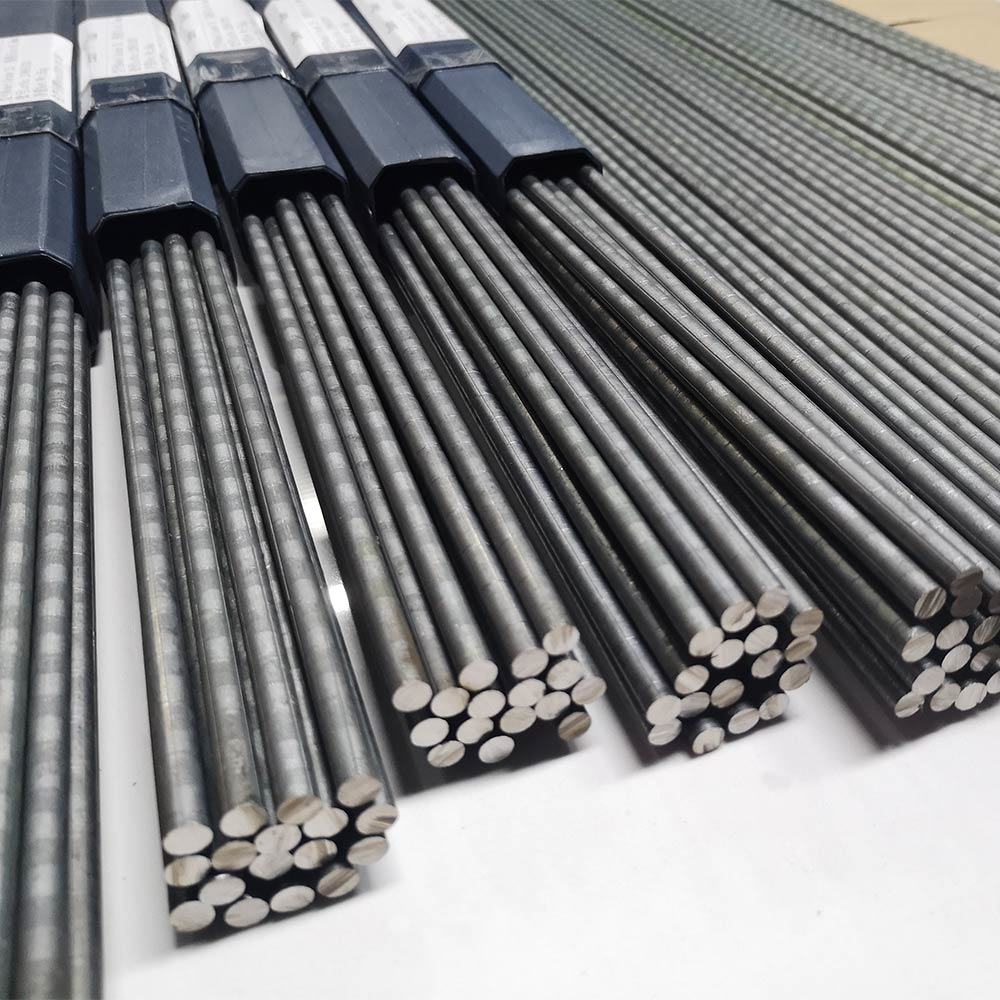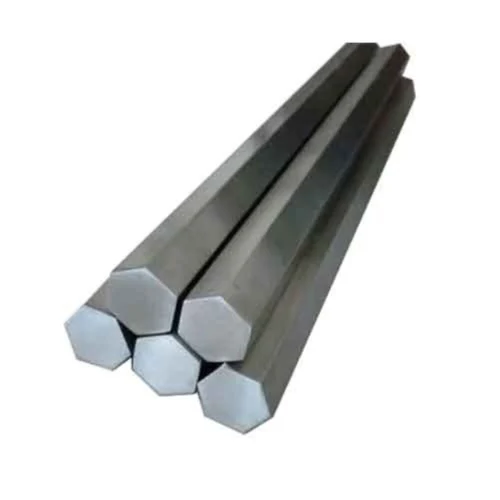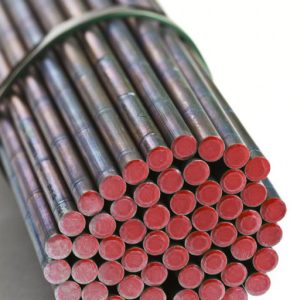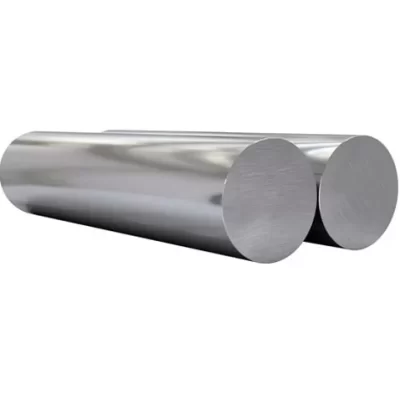Description
Description
This tungsten strengthened cobalt-chromium alloy is the cast version of the wrought alloy L605. A special low carbon material has been found to have exceptional thermal fatigue resistance and is useful for tools to work hot steel. The alloy also resists hot metal on metal wear.
Corrosion Resistance
Stellite® alloy 25 is resistant to oxidation and carburization up to 1900°F. The alloy resists wet chlorine at ambient temperatures and is resistant to nitric and hydrochloric acids under certain conditions. Exposure testing is recommended to verify performance.
Wear
Stellite® alloy 25 forms a protective oxide film during hot metal-on-metal wear which prevents metal transfer and damage due to adhesion. The alloy is resistant to thermal cracking and surface fatigue. Since the micro- structure is relatively free of carbide reinforcement, it is not recommended for low stress or low angle particle erosion service.
Finishing
Carbide tools allow a variety of conventional machining operations. Use positive rake angle to avoid burnishing since the alloy work hardens readily. Sharp tools and coolant are recommended for drilling.
Applications
Metal working tools where a combination of metal-on-metal wear, thermal fatigue and hot corrosion resistanceare required, such as piercing points, forming tools, and extrusion dies. Also used for furnace hardware.
Available forms
Castings, welding consumables.
Nominal Composition (Mass %) and Physical Properties
| Co | Cr | W | C | Others | Hardness | Density | Melting Range |
| Base | 20 | 15 | 0.1 | Ni, Fe, Si, Mo, Mn | 20-45 HRC* | 8.31 g/cm3 0.300 lb/in3 |
1329-1410ºC 2425-2573ºF |
Chemistry
| Nominal Composition (Weight%) | |
|---|---|
| Co | 51 Bal. |
| Ni | 10 |
| Cr | 20 |
| W | 15 |
| Fe | 3 Max. |
| Mo | 1 Max. |
| Mn | 1.5 |
| Si | 0.4 Max. |
| C | 0.1 |
Mechanical Properties
The typical properties listed can usually be provided in rounds, sheet, strip, plate, & custom forgings. We have the equipment to produce small quantities in special sizes to meet our customers’ specific needs. The table below shows Haynes’ Nominal Mechanical/Tensile Properties of Alloy 25 (L-605) Rod & Bars. For most common forms and exceptions, check out the datasheet linked underneath the table.
| Form | Cond. | UTS ksi (MPa) | 0.2% OS YS ksi (MPa) | Elong., % | Rockwell Hardness |
|---|---|---|---|---|---|
| Sheet | Solution Treated | 144.5 (996) | 69 (476) | 54.7 | 97B |
| Plate | Solution Treated | 145.1 (1000) | 68.7 (474) | 58.8 | 99B |
| Bar | HR & Solution Anneal | 147 (1015) | 73 (505) | 60 | 98B |
UTS = Ultimate Tensile Strength, YS = Yield Strength, OS = Offset, HR = Hot Rolled
Common Specifications
Note that the specifications listed are common for this alloy but are for reference only and may be specific to a certain form. The specifications listed are not comprehensive nor indicative of any edition, revision, or similar such as an amendment. Please, reach out to our sales department to request the Material Test Report (MTR) or to confirm your required specifications.
| Form | Standard |
|---|---|
| Identification | UNS R30605, EN 2.4964 |
| Bar | AMS 5759 |
| Cold Worked Bar | MCS 1031 |
| Sheet, Plate, or Strip | AMS 5537 |
| Forging | AMS 5759 |
| Weld Wire | AMS 5796 |
| Weld Electrode | AMS 5797 |
| Medical | ASTM F90 |
Physical Properties
| TYPICAL TENSILE PROPERTIES, COLD-WORKED SHEET | |||||||
|---|---|---|---|---|---|---|---|
| Cold Red. |
Test Temp. |
Ultimate Tensile Strength |
0.2% Yield Strength |
Elong. in 2 in. % |
|||
| °F | °C | Ksi | MPa | Ksi | MPa | ||
| 10 | 70 1000 1200 1400 1600 1800 |
20 540 650 760 870 980 |
155 114 115 87 62 39 |
1070 785 795 600 425 270 |
105 78 80 67 47 27 |
725 540 550 460 325 185 |
41 48 37 8 13 15 |
| 15 | 70 1000 1200 1400 1600 1800 |
20 540 650 760 870 980 |
166 134 129 104 70 40 |
1145 925 890 715 485 275 |
124 107 111 86 52 30 |
855 740 765 595 360 205 |
30 29 15 5 9 5 |
| 20 | 70 1000 1200 1400 1800 |
20 540 650 760 980 |
183 156 137 107 41 |
1260 1075 945 740 285 |
141 133 120 96 30 |
970 915 825 660 205 |
19 18 2 3 4 |
Cold Red. = Cold Reduced
Metal-to-Metal Galling Resistance
Cobalt Alloy L605 exhibits excellent resistance to metal galling. Wear results shown below were generated for standard matching material room-temperature pin on disc tests. Wear depths are given as a function of applied load. The results indicate that alloy L605 is superior in galling resistance to many materials, and is surpassed only by Ultimet® alloy and Stellite® alloy 6B. Both of these materials were specifically designed to have excellent wear resistance.
| Room-Temperature Wear Depth For Various Applied Loads | ||||||
|---|---|---|---|---|---|---|
| 3,000 lbs. (1.365 Kg) | 6,000 lbs. (2.725 Kg) | 9,000 lbs. (4.090 Kg) | ||||
| Alloy | mils | µm | mils | µm | mils | µm |
| Alloy 6B | 0.02 | 0.6 | 0.03 | 0.7 | 0.02 | 0.5 |
| Ultimet Alloy | 0.11 | 2.9 | 0.11 | 2.7 | 0.08 | 2.0 |
| Alloy L605 | 0.23 | 5.9 | 0.17 | 4.2 | 0.17 | 4.2 |
| Alloy 188 | 1.54 | 39.2 | 3.83 | 97.3 | 3.65 | 92.6 |
| HR-160™ alloy | 1.73 | 43.9 | 4.33 | 109.9 | 3.81 | 96.8 |
| 214™ alloy | 2.32 | 59.0 | 3.96 | 100.5 | 5.55 | 141.0 |
| 556™ alloy | 3.72 | 94.4 | 5.02 | 127.6 | 5.48 | 139.3 |
| 230™ alloy | 4.44 | 112.7 | 7.71 | 195.8 | 8.48 | 215.5 |
| HR-120™ alloy | 6.15 | 156.2 | 7.05 | 179.0 | 10.01 | 254.2 |
High Temperature Hardness Properties
The following are results from standard vacuum furnace hot hardness tests. Values are given in originally measured DPC (Vickers) units and conversions to Rockwell C/B scale in parentheses.
| Vickers Diamond Pyramid Hardness (Rockwell C/B Hardness) | |||||
|---|---|---|---|---|---|
| 70°F (20°C) | 800°F (425°C) | 1000°F (540°C) | 1200°F (650°C) | 1400°F (760°C) | |
| Solution Treated | 251 (RC22) | 171 (RB87) | 160 (RB83) | 150 (RB80) | 134 (RB74) |
| 15% Cold Work | 348 (RC22) | 254 (RC23) | 234 (RC97) | 218 (RC95) | — |
| 20% Cold Work | 401 (RC35) | 318 (RC32) | 284 (RC27) | 268 (RC25) | — |
| 25% Cold Work | 482 (RC48) | 318 (RC32) | 300 (RC30) | 286 (RC28) | — |
Aqueous Corrosion Resistance
Haynes 25 (L605) was not designed for resistance to corrosive aqueous media. Representative average corrosion data are given for comparison. For applications requiring corrosion resistance in aqueous environments, Ultimet alloy and Hastelloy’s corrosion-resistant alloys should be considered.
| Average Corrosion Rate, mils per year (mm per year) | |||
|---|---|---|---|
| 1% HCl (Boiling) | 10% H2SO4 (Boiling) | 65% HNO3 (Boiling) | |
| C-22™ alloy | 3 (0.08) | 12 (0.30) | 134 (3.40) |
| Alloy L605 | 226 (5.74) | 131 (3.33) | 31 (0.79) |
| Type 316L | 524 (13.31) | 1868 (47.45) | 9 (0.23) |
Oxidation Resistance
Cobalt alloy L605 exhibits good resistance to both air and combustion gas oxidizing environments and can be used for long-term continuous exposure at temperatures up to 1800°F (980°C). For exposures of short duration, alloy L605 can be used at higher temperatures.
| COMPARATIVE BURNER RIG OXIDATION RESISTANCE 1000-HOUR EXPOSURE AT 1800°F (980°C) | ||||||
|---|---|---|---|---|---|---|
| Metal Loss | Average Metal Affected |
Maximum Metal Affected |
||||
| Alloy | mils | µm | mils | µm | mils | µm |
| 230 Alloy | 0.8 | 20 | 2.8 | 71 | 3.5 | 89 |
| Alloy 188 | 1.1 | 28 | 3.5 | 89 | 4.2 | 107 |
| Alloy X | 2.7 | 69 | 5.6 | 142 | 6.4 | 153 |
| Alloy 625 | 4.9 | 124 | 7.1 | 180 | 7.6 | 193 |
| Alloy L605 | 6.2 | 157 | 8.3 | 211 | 8.7 | 221 |
| Alloy 617 | 2.7 | 69 | 9.8 | 249 | 10.7 | 272 |
| Alloy 800H | 12.3 | 312 | 14.5 | 368 | 15.3 | 389 |
| Type 310 Stainless Steel | 13.7 | 348 | 16.2 | 411 | 16.5 | 419 |
| Alloy 600 | 12.3 | 312 | 14.4 | 366 | 17.8 | 452 |
Oxidation Test Parameters
Burner rig oxidation tests were conducted by exposing samples 3/8 in. x 2.5 in. x thickness (9 mm x 64 mm x thickness), in a rotating holder, to products of combustion of No. 2 fuel oil burned at a ratio of air to fuel of about 50:1. (Gas velocity was about 0.3 mach). Samples were automatically removed from the gas stream every 30 minutes and fan-cooled to near ambient temperature and then reinserted into the flame tunnel.
| COMPARATIVE OXIDATION RESISTANCE IN FLOWING AIR | ||||||
|---|---|---|---|---|---|---|
| 1800°F (980°C) | 2000°F (1095°C) | 2100°F (1150°C) | ||||
| Alloy | mils | µm | mils | µm | mils | µm |
| Alloy 188 | 0.6 | 15 | 1.3 | 33 | 8.0 | 203 |
| 230 Alloy | 0.7 | 18 | 1.3 | 33 | 3.4 | 86 |
| Alloy L605 | 0.7 | 18 | 10.2 | 259 | 19.2 | 488 |
| Alloy 625 | 0.7 | 18 | 4.8 | 122 | 18.2 | 462 |
| Alloy X | 0.9 | 23 | 2.7 | 69 | 5.8 | 147 |
| Alloy 617 | 1.3 | 33 | 1.8 | 46 | 3.4 | 86 |
Thermal Stability
When exposed for prolonged periods at intermediate temperatures, Cobalt alloy L605 exhibits a loss of room temperature ductility in much the same fashion as some other solid-solution-strengthened superalloys, such as Hastelloy® alloy X OR Inconel® ALLOY 625. This behavior occurs as a consequence of the precipitation of deleterious phases. In the case of alloy L605, the phase in question is CO2 W laves phase. Haynes® alloy 188 is significantly better in this regard than alloy L605.
| ROOM-TEMPERATURE PROPERTIES OF SHEET AFTER THERMAL EXPOSURE* | ||||||
|---|---|---|---|---|---|---|
| Exposure Temp. °F (°C) |
Hours | Ultimate Tensile Strength |
0.2% Yield Strength |
Elong. % |
||
| Ksi | MPa | Ksi | MPa | |||
| None | 0 | 135.0 | 930 | 66.8 | 460 | 48.7 |
| 1200 (650) | 500 1000 2500 |
123.6 140.0 130.7 |
850 965 900 |
70.3 92.3 95.1 |
485 635 655 |
39.2 24.8 12.0 |
| 1400 (760) | 100 | 115.3 | 795 | 68.9 | 475 | 18.1 |
| 1600 (870) | 100 500 1000 |
113.6 126.1 142.0 |
785 870 980 |
72.1 77.3 81.7 |
495 535 565 |
9.1 3.5 5.0 |
Machining
The alloys described here work harden rapidly during machining and require more power to cut than do the plain carbon steels. The metal is ‘gummy,’ with chips that tend to be stringy and tough. Machine tools should be rigid and used to no more than 75% of their rated capacity. Both work piece and tool should be held rigidly; tool overhang should be minimized. Rigidity is particularly important when machining titanium, as titanium has a much lower modulus of elasticity than either steel or nickel alloys. Slender work pieces of titanium tend to deflect under tool pressures causing chatter, tool rubbing, and tolerance problems. Make sure that tools are always sharp. Change to sharpened tools at regular intervals rather than out of necessity. Titanium chips in particular tend to gall and weld to the tool cutting edges, speeding up tool wear and failure. Remember- cutting edges, particularly throw-away inserts, are expendable. Don’t trade dollars in machine time for pennies in tool cost.
Feed rate should be high enough to ensure that the tool cutting edge is getting under the previous cut thus avoiding work-hardened zones. Slow speeds are generally required with heavy cuts. Sulfur chlorinated petroleum oil lubricants are suggested for all alloys but titanium. Such lubricants may be thinned with paraffin oil for finish cuts at higher speeds. The tool should not ride on the work piece as this will work harden the material and result in early tool dulling or breakage. Use an air jet directed on the tool when dry cutting to significantly increase tool life.
Lubricants or cutting fluids for titanium should be carefully selected. Do not use fluids containing chlorine or other halogens (fluorine, bromine or iodine), in order to avoid risk of corrosion problems. The following speeds are for single point turning operations using high speed steel tools. This information is provided as a guide to relative machinability, higher speeds are used with carbide tooling.
| Material | Speed Surface ft/mm |
Speed %B1112 |
|---|---|---|
| AISI B1112 | 165 | 100 |
| Rene 41 | 12 | 7 |
| 25 (L-605) | 15 | 9 |
| 188 | 15 | 9 |
| N-155 | 20 | 12 |
| Waspaloy | 20 | 12 |
| 718 | 20 | 12 |
| 825 | 20 | 12 |
| X | 20 | 12 |
| RA333 | 20-25 | 12-15 |
| A-286 | 30 | 18 |
| RA330 | 30-45 | 18-27 |
| HR-120® | 30-50 | 18-30 |
| Ti 6Al-4V – solution annealed – aged |
30-40 15-45 |
18-30 9-27 |
| RA 353 MA~ | 40-60 | 25-35 |
| 20Cb-3~ | 65 | 40 |
| AL6xN~ | 65 | 40 |
| RA309 | 70 | 42 |
| RA310 | 70 | 42 |
| 304 | 75 | 45 |
| 321 | 75 | 45 |
| 446 | 75 | 45 |
| Greek Ascoloy Annealed | 90 | 55 |
| Hardened Rc35 | 50 | 30 |
| 303 | 100 | 60 |
| 416 | 145 | 88 |
| 17-4 PH – solution treated – aged Hi 025 |
75 60 |
45 36 |





Reviews
There are no reviews yet.